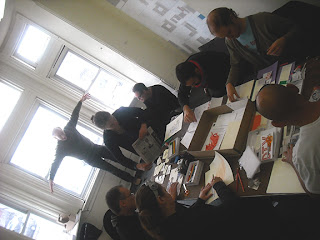The manufactured “outrage” at two of Kehinde Wiley’s models from 2012, posing as Judith, holding the severed heads of young white female stand-ins for Holofernes, is tiresome. But I guess it needs some deconstructing.
First—By the numbers:
- Per Wiley’s website, the two paintings in question are 2 of 35 paintings he produced in 2012.
- They are the only 2 paintings on his website that feature disembodied heads.
- There are over 200 paintings featured on his website.
- That is not his full output.
- Meaning that w-a-y less than 1% of his painted output involves severed heads.
Second—Process:
- Wiley works with his models to choose a pose.
- That typically means he gives them a bunch of books and they choose poses.
- No young white women were actually beheaded during the production of the paintings.
Third—Meaning:
As my name probably betrays, I’m a white male, which has entitled me to certain privileges. For instance:
- When I am stopped by a police officer (which is seldom), I don’t fear I am going to get shot for no reason.
- If I am shoveling my driveway, I don’t worry about getting harassed by the police.
- If I’m locked out of my house and need to break in, it’s unlikely I’ll get arrested for doing so.
- If I’m shopping in a store, and I happen to be wearing an item the the store typically sells, I don’t get charged a second time for the merchandise. I also don’t get followed around the store.
I could go on.
I also am not an ancestor of American slaves. No member of my family has been denied the right to vote, own property, or run a business based on their skin color. There is no record of anyone in my family being lynched, tortured, murdered, or raped because of their skin color.
Again, I could go on.
I also don’t go around not finding representations of me. if I am looking for a toy/doll for my kids, I have no difficulty finding a white toy/doll. If I am looking for children’s books, I don’t have difficulty finding white protagonists for my kids to read about. If I am looking for role-models for my children to look-up to, I don’t have difficulty finding white people in a-n-y profession to point to and declare, “see, some day you can be that too.”
I don’t know what the weight of any of that feels like, and I don’t carry that burden on my shoulders daily. But the two women that Wiley painted: they might. So if they want to be painted into a fictitious fantasy that symbolizes a turned tale of racial power, without it actually killing anyone, let them. It doesn’t make them racist. It doesn’t make Wiley racist for painting it. And it doesn’t make President Obama racist for choosing Wiley to paint his portrait—with or without an imagined sperm on his head.
It might open up a dialog about institutional racism, and the historic oppression of a populace. To some extent, that is what the book Judith is about.
By saying Wiley should not have painted those two paintings is saying that Wiley is not permitted to engage that discussion: no matter how indirect or inarticulate that attempt may be perceived.
And to say the 44th President cannot have Wiley paint his portrait because of those two paintings—the 44th President who was the daily recipient of racial epithets—is ridiculous. It’s also irrelevant. There was nothing he could do during his 8 years in office that would have pleased the racist critics, and the very act of having his portrait painted—even in the most staid of depictions—would be dissatisfactory to them.
By the very nature of the painting, and its stark break from tradition, there are many reasons people can dislike Wiley's unfamiliar approach to presidential portraiture, or President Obama's choice to use Wiley. I don't agree with the negative criticisms, but I understand those perspectives. Needing to invent some "hidden racist agenda" to dismiss the painting is weak tea, and for most of those parroting the criticism, probably a way to mask your own racism.











